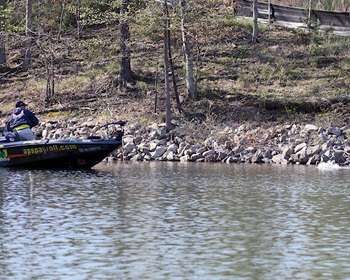
Anyone who has ever attempted to coax a bedding bass into biting knows well the frustrations the technique can often carry. Chief among them is the bass' disinterest in the angler's offering.
Elite Series pro James Niggemeyer suggests that about 90 percent of the time, a bass becomes wary because it has spotted the angler's profile silhouetted against the sky, creating a no-win scenario, regardless of the presentation.
To avoid this, Niggemeyer will do everything he can to reduce his profile when eying a bedding bass. "Initially when I see a bass in shallow water and I'm not sure if it's locked onto a bed, that first cast can be super critical," he reveals. "I don't want to spook it because if I only get one cast, I want to make it count." Short of making himself invisible, Niggemeyer goes to great lengths to ensure he's not a looming figure over the bass' shoulder
. "I think that the tall figure of an angler on a casting deck can spook a bass that might otherwise be catchable," he explains. "If the sun is behind me, I definitely do not want to allow my shadow to cast over the bed. It's a defensive mechanism; that bass is immediately on guard." As evidenced by his Smith Mountain performance, where Niggemeyer crouched on the deck of his Basscat to avoid being spotted by a bedding bass, not revealing a large profile is something he's extremely conscious of while bed fishing. "It's just one of those things that I'm extremely careful with.
Particularly in superclear water, I think a bedding bass is keen to the horizon," he explains. When hunkered down, Niggemeyer notes that it can be cumbersome to cast — and it can be even more difficult to pinpoint the bed's sweet spot. "I'll try to make a mental note of something in direct relation to the bed when I first spot it," he explains.
"It might be an off-colored leaf, a twig sticking out of the water, or even a bare spot on the bank. Just something that will give me a reference to precisely where the bed is located. Generally, I want to cast past my reference point and bring it into the bed. You never want your bait to fall into the bed on the cast." Niggemeyer believes that the bass will react to a new feature on their visual horizon, not just a human form.
"I don't think they can identify people, necessarily, but a change to their visual horizon can many times be the difference between their biting and not." he says. "You will rarely have any success bed fishing if you're hovering over a bed. That's just common sense.
At the same time, though, you want to make sure that — even from a distance — you're not creating a shadow or profile that can enter the bass' field of vision."
(Provided exclusively to BASS Insider by Z3 Media)




